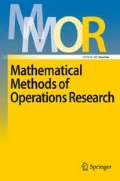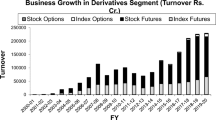Abstract
The continuous-time Markov chain (CTMC) approximation method is a powerful tool that has recently been utilized in the valuation of derivative securities, and it has the advantage of yielding closed-form matrix expressions suitable for efficient implementation. For two types of popular path-dependent derivatives, the arithmetic Asian option and the occupation-time derivative, this paper obtains explicit closed-form matrix expressions for the Laplace transforms of their prices and the Greeks of Asian options, through the novel use of pathwise method and Malliavin calculus techniques. We for the first time establish the exact second-order convergence rates of the CTMC methods when applied to the prices and Greeks of Asian options. We propose a new set of error analysis methods for the CTMC methods applied to these path-dependent derivatives, whose payoffs depend on the average of asset prices. A detailed error and convergence analysis of the algorithms and numerical experiments substantiate the theoretical findings.





Similar content being viewed by others
References
Abate J, Whitt W (1992) The Fourier-series method for inverting transforms of probability distributions. Queueing Syst 10:5–87
Asmussen S, Jensen JL, Rojas-Nandayapa L (2016) Exponential family techniques for the lognormal left tail. Scand J Stat 43:774–787
Atkinson K, Han W (2005) Theoretical numerical analysis: a functional analysis framework. Springer, New York
Borgonovo E (2010) Sensitivity analysis with finite changes: an application to modified EOQ models. Eur J Oper Res 200:127–138
Borgonovo E, Plischke E (2016) Sensitivity analysis: a review of recent advances. Eur J Oper Res 248:869–887
Borgonovo E, Buzzard GT, Wendell RE (2018) A global tolerance approach to sensitivity analysis in linear programming. Eur J Oper Res 267:321–337
Boyle P, Potapchik A (2008) Prices and sensitivities of Asian options: a survey. Insur Math Econ 42:189–211
Broadie M, Glasserman P (1996) Estimating security price derivatives using simulation. Manag Sci 42:269–285
Cai N, Chen N, Wan X (2010) Occupation times of jump-diffusion processes with double exponential jumps and the pricing of options. Math Oper Res 35:412–437
Cai N, Song Y, Kou S (2015) A general framework for pricing Asian options under Markov processes. Oper Res 63:540–554
Capriotti L (2011) Fast Greeks by algorithmic differentiation. J Comput Finance 14:3–35
Cui Z, Taylor S (2020) Pricing discretely monitored barrier options under Markov processes using a Markov chain approximation. J Deriv. https://doi.org/10.2139/ssrn.3382236
Cui Z, Kirkby JL, Nguyen D (2017a) A general framework for discretely sampled realized variance derivatives in stochastic volatility models with jumps. Eur J Oper Res 262:381–400
Cui Z, Kirkby JL, Nguyen D (2017b) Equity-linked annuity pricing with cliquet-style guarantees in regime-switching and stochastic volatility models with jumps. Insur Math Econ 74:46–62
Cui Z, Kirkby JL, Nguyen D (2018a) A general valuation framework for SABR and stochastic local volatility models. SIAM J Financ Math 9:520–563
Cui Z, Lee C, Liu Y (2018b) Single-transform formulas for pricing Asian options in a general approximation framework under Markov processes. Eur J Oper Res 266:1134–1139
Cui Z, Kirkby JL, Nguyen D (2019a) A general framework for time-changed Markov processes and applications. Eur J Oper Res 273:785–800
Cui Z, Kirkby JL, Nguyen D (2019b) Continuous-time markov chain and regime switching approximations with applications to options pricing. In: Yin G, Zhang Q (eds) Modeling, stochastic control, optimization, and applications. The IMA Volumes in Mathematics and its Applications, vol 164. Springer, Berlin
Ding K, Cui Z, Wang Y (2020) A Markov chain approximation scheme for option pricing under skew diffusion. Quant Finance. https://doi.org/10.2139/ssrn.3406811
Eriksson B, Pistorius MR (2015) American option valuation under continuous-time Markov chains. Adv Appl Probab 47:378–401
Feng R, Volkmer HW (2015) Conditional Asian options. Int J Theor Appl Finance 18:1–24
Fournié E, Lasry JM, Lebuchoux J, Lions PL, Touzi N (1999) Applications of Malliavin calculus to Monte Carlo methods in finance. Finance Stoch 3:391–412
Fu MC, Madan DB, Wang T (1999) Pricing continuous Asian options: a comparison of Monte Carlo and Laplace transform inversion methods. J Comput Finance 2:49–74
Fusai G (2000) Corridor options and arc-sine law. Ann Appl Probab 10:634–663
Fusai G, Kyriakou I (2016) General optimized lower and upper bounds for discrete and continuous arithmetic Asian options. Math Oper Res 41:531–559
Fusai G, Tagliani A (2001) Pricing of occupation time derivatives: continuous and discrete monitoring. J Comput Finance 5:1–38
Geman H, Yor M (1993) Bessel processes, Asian options, and perpetuities. Math Finance 3:349–375
Heidergott B, Volk-Makarewicz W (2015) A measure-valued differentiation approach to sensitivities of quantiles. Math Oper Res 41:293–317
Horn RA, Johnson CR (1985) Matrix analysis. Cambridge University Press, Cambridge
Kang W, Lee JM (2018) Unbiased sensitivity estimation of one-dimensional diffusion processes. Math Oper Res (forthcoming)
Kirkby JL (2016) An efficient transform method for Asian option pricing. SIAM J Financ Math 7:845–892
Kirkby JL, Nguyen D, Cui Z (2017) A unified approach to Bermudan and barrier options under stochastic volatility models with jumps. J Econ Dyn Control 80:75–100
Kushner H, Dupuis PG (2013) Numerical methods for stochastic control problems in continuous Time. Springer, Berlin
Ladyzhenskaia OA, Solonnikov VA, Ural’tseva NN (1988) Linear and quasi-linear equations of parabolic type. American Mathematical Society, Providence
Leitao Á, Ortiz-Gracia L, Wagner EI (2018) SWIFT valuation of discretely monitored arithmetic Asian options. J Comput Sci 28:120–139
Leitao Á, Kirkby JL, Ortiz-Gracia L (2020) The CTMC-Heston model: calibration and exotic option pricing with SWIFT. J Comput Finance (to appear). Preprint available at SSRN: https://ssrn.com/abstract=3471806
Li L, Zhang G (2018) Error analysis of finite difference and Markov chain approximations for option pricing. Math Finance 28:877–919
Linetsky V (1999) Step options. Math Finance 9:55–96
Lo CC, Skindilias K (2014) An improved Markov chain approximation methodology: derivatives pricing and model calibration. Int J Theor Appl Finance 17:1450047
Mijatović A, Pistorius M (2013) Continuously monitored barrier options under diffusion processes. Math Finance 23:1–38
Phelan CE, Marazzina D, Fusai G, Germano G (2018) Fluctuation identities with continuous monitoring and their application to the pricing of barrier options. Eur J Oper Res 271:210–223
Phelan CE, Marazzina D, Germano G (2019) Pricing methods for \(\alpha \)-quantile and perpetual early exercise options based on spitzer identities. Working paper available at SSRN: https://doi.org/10.2139/ssrn.3378520
Plischke E, Borgonovo E (2019) Copula theory and probabilistic sensitivity analysis: Is there a connection? Eur J Oper Res 277:1046–1059
Plischke E, Borgonovo E, Smith CL (2013) Global sensitivity measures from given data. Eur J Oper Res 226:536–550
Protter PE (2005) Stochastic integration and differential equations. Springer, New York
Segaud A (2011) Alternative solutions for variable annuity hedging. Equity-based insurance guarantees conference, Chicago. Available at https://docplayer.net/5409701-Equity-based-insurance-guarantees-conference-november-14-15-2011-chicago-il-alternative-solutions-for-variable-annuity-hedging.html
Song Y, Cai N, Kou SG (2018) Computable error bounds of Laplace inversion for pricing Asian options. INFORMS J Comput 30:634–645
Tavella D, Randall C (2000) Pricing financial instruments: the finite difference method. Wiley, New York
Tian YS (2013) Ironing out the kinks in executive compensation: linking incentive pay to average stock prices. J Bank Finance 37:415–432
Wilmott P, Dewynne J, Howison S (1993) Option pricing: mathematical models and computation. Oxford Financial Press, Oxford
Zhang G, Li L (2019) Analysis of Markov chain approximation for option pricing and hedging: grid design and convergence behavior. Oper Res 67:407–427
Zhang B, Oosterlee CW (2013) Effcient pricing of European-style Asian options under exponential Lévy processes based on Fourier cosine expan- sions. SIAM J Financ Math 4:339–416
Zvan R, Forsyth PA, Vetzal K (1998) Robust numerical methods for PDE models of Asian options. J Comput Finance 1:39–78
Author information
Authors and Affiliations
Corresponding author
Additional information
Publisher's Note
Springer Nature remains neutral with regard to jurisdictional claims in published maps and institutional affiliations.
The work was supported by National Natural Science Foundation of China (Grant No. 11671323), Program for New Century Excellent Talents in University of China (Grant No. NCET-12-0922), and the Fundamental Research Funds for the Central Universities of China (JBK1805001).
A Proof of Propositions 2.1 and 2.2 and Lemma 2.1
A Proof of Propositions 2.1 and 2.2 and Lemma 2.1
Proof of Proposition 2.1
The main steps of the proof are similar to that of (Cai et al. 2015, Theorem 1), thus we shall only present the steps where significant changes need to be made. In particular, note that for the case of occupation time functional, we can relax the assumption by not requiring any moment conditions on S. Suppose that f is any bounded solution to the functional equation (6). Define
We shall first establish a useful identity:
The proof of this identity is essentially very similar to that of Cai et al. (2015), and the following steps need adjustment: we have the same decomposition as in (Cai et al. 2015, A3): For any fixed \(t\ge 0\),
and for the first term of (A.3), we have
and we do not need to assume any moment condition and the remaining analysis follows. For the second part of (A.3), just note that \(\mid \mathcal {G}f(x)\mid =\mid (\varsigma +\theta )f(x)-1 \mid \le (\mid \varsigma \mid +\mid \theta \mid )C+1\), then we can apply dominated convergence theorem to similarly conclude that the identity (A.2) holds. Then we can establish the remaining results using the lemma similarly as Cai et al. (2015) does. This completes the proof. \(\square \)
Proof of Proposition 2.2
The proof is similar to that of Cai et al. (2015), and the following key steps need adjustment: For the first corresponding term with the same form as (A.3), when \(u\in (0,u_0)\) with any fixed \(u_0>0\)
and given that we have assumed the moment condition: \(\mathbb {E}^x[S_t^{1+\epsilon }]<\infty \) for some \(\epsilon >0\), we have from Doob’s inequality that the right-hand side of (A.5) is bounded. The remaining steps follow similarly from Cai et al. (2015). This completes the proof. \(\square \)
Proof of Lemma 2.1
Under the condition that \(\hbox {Re}(\varsigma ) >\Vert \mathbf{G}-\theta \mathbf{A}-\gamma \mathbf{B}\Vert \), then \(\left\| \frac{\mathbf{G}-\theta \mathbf{A}-\gamma \mathbf{B}}{\varsigma }\right\| <1\). From Hom and Johnson (1985, Corollary 5.6.16), we can obtain that
Plugging (9) and (A.6) into (7) yields
Taking the inverse Laplace transform w.r.t. \(\varsigma \) on both hand sides of the above equation, we can obtain
This completes the proof. \(\square \)
Rights and permissions
About this article
Cite this article
Yang, W., Ma, J. & Cui, Z. Analysis of Markov chain approximation for Asian options and occupation-time derivatives: Greeks and convergence rates. Math Meth Oper Res 93, 359–412 (2021). https://doi.org/10.1007/s00186-020-00735-5
Received:
Revised:
Accepted:
Published:
Issue Date:
DOI: https://doi.org/10.1007/s00186-020-00735-5
Keywords
- Option pricing
- Sensitivity analysis
- Continuous-time Markov chains
- Non-uniform grids
- Convergence rates
- Path-dependent options
- Greeks
- Laplace inversion




